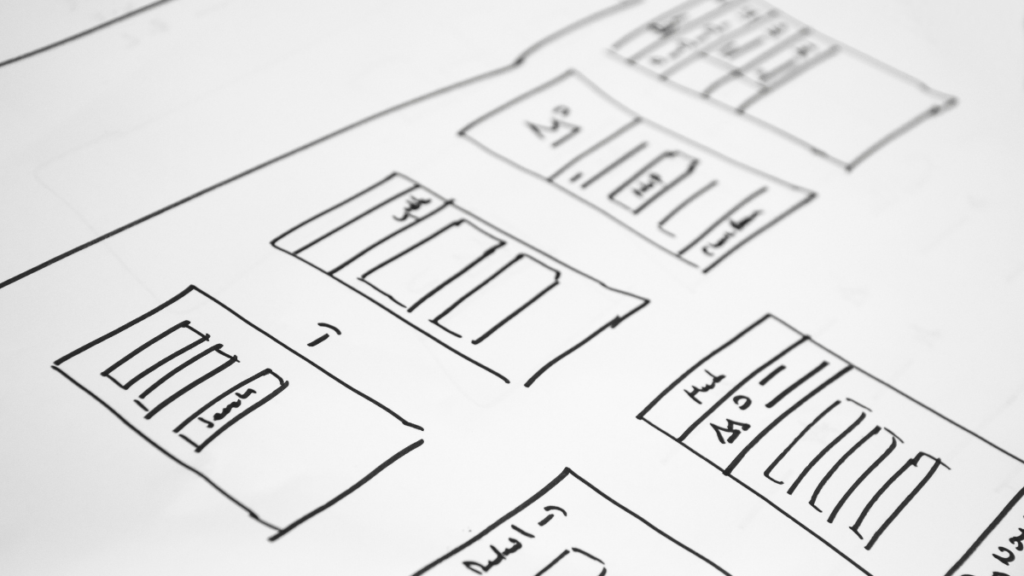Designing an engaging digital product requires a user focused approach. Through UX workshop exercises you will discover who your customers are, what they need and how best to create an effective interface to meet their requirements. But that’s not the only benefit, the UX design process gives you the opportunity to tweak the design based on the data and feedback you receive and will help you improve your user journey.
Putting your customer first is key to the success of your digital product. That’s why we have listed the 10 most important deliverables from a UX workshop.
Contents
- 1. Definition of Goals and Technical Specifications
- 2. User Personas
- 3. Competitor Analysis
- 4. Information Architecture and Sitemap
- 5. User Journeys and User Flows
- 6. Wireframes
- 7. High Fidelity Designs
- 8. Interactive Prototypes
- 9. User Testing
- 10. Specifications and Style Guides
- Learn more about the UX design process

1. Definition of Goals and Technical Specifications
One of the first steps in the UX design process is understanding the product vision. This should be no more than a couple of pages and should include the challenge that is being solved, the solution, and an outline of the target audience. It should also detail the platforms and technologies that will be used to deliver the product, covering the what, why and how.
2. User Personas
A user persona is a fictional description of your typical user. User personas are used to pin down the demographics, behaviours, and pain points of your target users.
Although a persona summarises the information into a realistic description of a single user, it represents a much larger group of users. User personas give you a clear picture of who your users are and how they behave. In other words, you can make UX design choices based on user data rather than gut feeling or personal preference.
3. Competitor Analysis
Competitive analysis: “Identifying your competitors and evaluating their strategies to determine their strengths and weaknesses relative to those of your own product or service.”
It’s essential to validate your product and ensure it is a good market fit. As part of the UX discovery workshop it’s critical to ensure the product has an advantage over its competitors and a UX that is unrivalled in its market.
4. Information Architecture and Sitemap
Another of the UX workshop activities to be undertaken will be the creation of a sitemap. This is a visual representation of the structure and information contained within the digital product.
The sitemap is one of the fundamental deliverables of the UX process and helps organise the information architecture, such as the navigation. The sitemap will evolve during the UX research, prototyping and user testing, whilst acting as a reference throughout the iterative process.
5. User Journeys and User Flows
A user flow is a visual diagram that depicts the steps a user will take when interacting with your product. There will be multiple user flows, which will illustrate the different journeys and ways in which the user will engage with your user interface. These journeys will start when the user enters your product all the way through to the final action they take. Having a visual overview of this journey enables the design team to optimise for better conversion rates.

6. Wireframes
When you think of the term user experience you will likely envisage illustrative wireframes. They are a staple of the UX design methodology and are an early design layout to help define the positioning of content, functionalities and intended user behaviours.
Wireframing is a great way to explore concepts and innovative ideas that meet your users goals. They are often provided as low-fidelity (black and white boxes with no styling) but can also be high-fidelity (fully styled with color and detail).
7. High Fidelity Designs
High-fidelity visuals give you a better understanding of what the final product will look like. It will be a high quality, computer-generated visual design that allows you to test your user journeys.
Since they closely replicate the final product, they are often used to demonstrate the product to stakeholders or investors, or to collect early user feedback.
8. Interactive Prototypes
Interactive prototypes are treated as the first iteration of your digital product. Its purpose is to breathe life into your product and give you the opportunity to test how it will look and more importantly how it will work. This is the ideal time to identify anything that needs tweaking before development starts. For more insights about interactive prototypes read our guide to low-fidelity vs. high-fidelity prototypes.
9. User Testing
User testing can be undertaken at various stages of the UX process, but is typically most valuable once you have a clickable prototype or minimum viable product available. For the best results, one-to-one user observations are favourable as they give you the chance to learn the thought processes behind the user behaviour.
Usability testing will help identify whether your target users are able to use your product and will uncover challenges they are having with specific user interface UI design.
Once you have launched your product you will be able to start gathering more data on a large scale and tweak your product accordingly.
10. Specifications and Style Guides
The final step in the UX design process is packaging up the specifications and style guides for the development team. Style guides are used to ensure consistent branding, colour ways, fonts, typography and visual styling. They are also important for design patterns, language and rules as well as detailing UI behaviours, such as error handling.
Learn more about the UX design process
The UX and UI design team at Code23 have been crafting successful digital products since 2004. Empowering businesses to create engaging digital experiences based on an understanding of human behaviours and motivations, culminating in user centered products that your users will love.
Get in touch and speak to our award winning design team about how we can support your next project.
